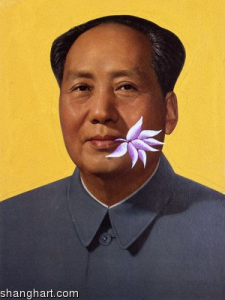 By: Bo Hershey, Class of 2012
By: Bo Hershey, Class of 2012
The Shanghai Propaganda Poster Art Centre provides viewers with a place of historical reference. When viewing the various forms of Chinese propaganda one sees that each period had its unique style. When looking even deeper one finds that every poster tells a different story. When observing the propaganda posters of the Cultural Revolution the viewer is provided with primary source of that era. These posters are not similar to contemporary art forms of the 21st century. Instead they speak to the sensibilities of that time. The collection of posters found at the Propaganda Center shows the kinds of art forms accepted under Mao. The visual language of each poster shows that political propaganda was the major art form of that era. Each poster seems to have the same kind of political tone. Yet the themes of each of the posters seem to tell a different story. A few are a glorification of Chairman Mao. Here the posters show Mao as a cult figure. When looking at these posters one can see similarities to the Spanish baroque paintings that presented the Hapsburgs as regal leaders of their domain. The poster artists of the Mao era follow a similar technique by making Mao the central figure of the poster. The anti-Western bias is another interesting feature found in many of the posters. These kinds of posters were used as a way to change the viewers perception in a negative light. Propaganda in many ways is an art form whose purpose is to influence the viewer into believing the story presented. Basically, the posters of this era are no different from those other art works. The role of the viewer is to understand the artist’s objective and make judgments that question the reason for its creation.

Entering the Jade Buddha Temple serves as a brief respite from the stresses modern Shanghai presents. Within the temple grounds, monks patrol in groups and chant with the assistance of instrumentation. The monks aren’t too loud, but one feels as though they could be heard from anywhere on the temple grounds. The temple itself is resplendent in shades of red and gold, striking the eye but never appearing too garish. The massive human figures within the temple appear much the same way; imposing and colorful, but demanding of respect and attention. The larger-than-life statues of deities tower over patrons of the temple, and the soft red cushions on the floor before them practically demand anyone who enters to genuflect. Within the courtyard, billowing pillars of smoke stem from ancient cauldrons where 21st-century Shanghai reconnects with its past. Either one by one or in small groups, people take smoking sticks and bow towards each of the compass directions. But it is not a somber affair. A woman drops her torch after nearly burning herself and shrieks in simultaneous fright and excitement. No one shushes her or appears upset, beyond making sure she’s okay.
Learn more about Bo’s Study Away experience HERE.